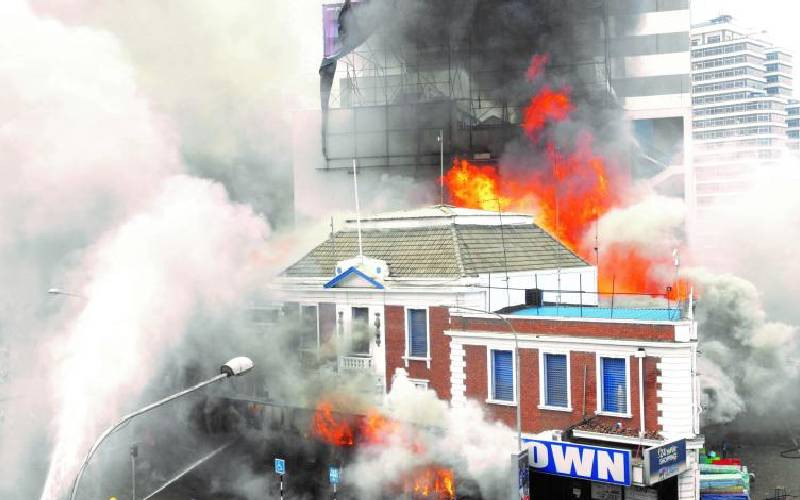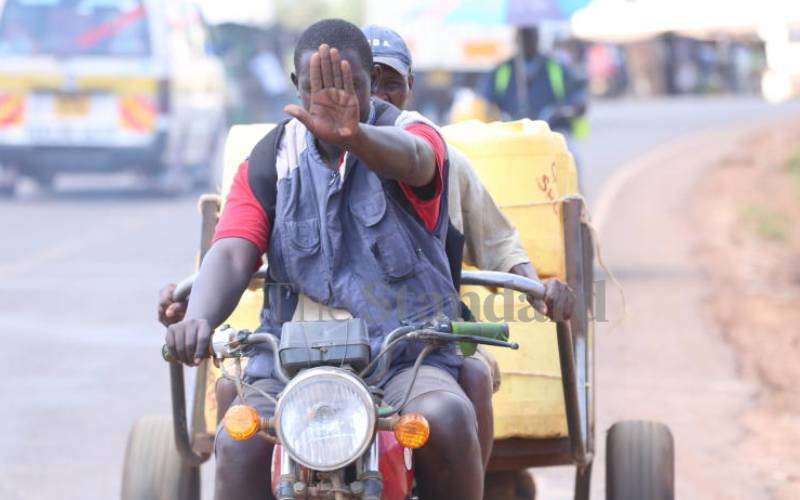By John Oywa
Flash back, 1965. President Jomo Kenyatta arrives at the Eastleigh Air Base in Nairobi to inspect a parade mounted by a platoon of young air force men.
Conducting him through the parade is Frederick Collins Omondi Oyoo, a jet fighter pilot who had just returned from the Royal Air Force Training College in the UK.
Confident, Omondi, 20, takes Kenyatta through the slow paced walk as the Air Force band plays a soft tune in the background. Moments later, an impressed Kenyatta decorates Omondi with Sword of Merit Medal Award for a job well done. |
Frederick Omondi, right, guides President Jomo Kenyatta as he inspects a guard of honour at the Eastleign Air Base in Nairobi in 1965. Omondi was to later get into Kenyatta’s bad books over the coup attempt. Photo: courtesy |
Six years later, Omondi disappears from the barracks and is on the run. Security agents are hot on his heels after a coup attempt against Kenyatta in which he played a leading role came a cropper. The 26-year-old slipped into Tanzania where he was to be confined by the then President Julius Nyerere’s government for one year before being repatriated to Kenya to face coup attempt charges that earned him ten years in jail.
Last week, 39 years after the coup attempt, The Standard traced the former soldier, now 65, to Kisumu.
He narrated the story of the failed 1971 coup, its leaders and why it flopped. "The plan to topple Kenyatta was hatched at Lanet Barracks in Nakuru by a group of soldiers led by one Lieutenant Owino, who is now living in exile in Britain. It was the culmination of tension that had gripped the country and the Armed Forces after the political events that followed the assassination of Tom Mboya and detention of Jaramogi Oginga Odinga," he says.
There was discontent in the barracks and officers wanted not only a change in political leadership, but also in management of the Armed Forces. "We also wanted better pay besides a new political dispensation," he adds. The original plan was to have simultaneous coups in East Africa.
Omondi explains: "Idi Amin had just ousted Milton Obote but he was against an integrated East Africa so we wanted him out alongside Kenyatta. The three presidents had refused to unite and we wanted to unite them by force the way Otto Van Bismarck united Germany."
Parables and coded words
As a pilot, Omondi had access to all other barracks and air bases in the country. For this reason, he was made the coup’s co-ordination and liaison officer. "I met many soldiers and convinced them to support our cause. I used parables and coded words to avoid being suspected. I converted many soldiers and we were all set for the big day — April 8, 1971," Omondi offers. However, the planners were not sure it would be easy to overthrow Kenyatta.
"Whatever the case, we reminded ourselves about the popular saying by Karl Marx that ‘if the battle fails, it can only be postponed and not called off’. We knew the battle against inequality in the country had to be won and that if it failed, we could only postpone it to another day. And it was postponed to 1982," he says.
Omondi says the 1971 coup was better organised than the one that followed eleven years later in 1982.
"Unlike the 1982 failed coup, which was planned by junior officers, ours involved top brains and officers in the military," he says.
The former Air Force pilot says the person who would succeed Kenyatta and a Cabinet had been picked.
"I was one of the people who had been proposed to be in the Cabinet. We planned to take over strategic installations such as the Voice of Kenya (now Kenya Broadcasting Services), but it was agreed we were to guard against looting and destruction of property because people committed to forming a new government cannot plunder their own country," he says.
Then things started going wrong with only a few days to the D-day. A decision was made to send Prof Ouma Muga, a university lecturer who was one of those earmarked for top posts in the new regime and Lieutenant Owino to seek support from President Nyerere. They travelled to Tanzania under the cover of darkness. "This was our mistake number one.
By revealing our coup plan to Nyerere, we had bitten more than we could chew. Nyerere sent the two back empty handed, saying he could not support a coup against Kenyatta," he says. Thereafter, word leaked about our plans and hell broke lose!
Omondi says: "I learnt from colleagues that Special Branch officers were looking for me because of my role in the failed coup. I could not wait because I knew they would kill me. I left Nairobi in my saloon car at dusk and drove towards the Kenya-Tanzania border. By the time the police sent signals to all border crossing points to have me intercepted, I was safely in Tanzania cruising towards the capital Dar es Salaam."
Swap prisoners
In Dar es Salaam, he gave himself up and was driven to the old State House where he was confined for a year. Tanzania later agreed to exchange prisoners with Kenya, which saw him handed to the Kenyan authorities.
"I expected the worst," he says.
Once in Nairobi, Omondi was locked up in different police stations. Special Branch officials grilled him for long periods.
"I told them that I wanted to overthrow the Government because I was unhappy with the way Kenya was being governed especially after Mboya’s assassination. I told them tribalism was killing the country and that the military was discriminating against certain communities," he says.
Omondi says he explained to the officers the coup was not by ‘disgruntled Luo’ as it had been branded.
"We suffered in prison but I have no regrets because we planted the seeds of change, which have slowly grown into a strong wind of change," he says.
 The Standard Group Plc is a multi-media organization with investments in media
platforms spanning newspaper print operations, television, radio broadcasting,
digital and online services. The Standard Group is recognized as a leading
multi-media house in Kenya with a key influence in matters of national and
international interest.
The Standard Group Plc is a multi-media organization with investments in media
platforms spanning newspaper print operations, television, radio broadcasting,
digital and online services. The Standard Group is recognized as a leading
multi-media house in Kenya with a key influence in matters of national and
international interest.
 The Standard Group Plc is a multi-media organization with investments in media
platforms spanning newspaper print operations, television, radio broadcasting,
digital and online services. The Standard Group is recognized as a leading
multi-media house in Kenya with a key influence in matters of national and
international interest.
The Standard Group Plc is a multi-media organization with investments in media
platforms spanning newspaper print operations, television, radio broadcasting,
digital and online services. The Standard Group is recognized as a leading
multi-media house in Kenya with a key influence in matters of national and
international interest.










